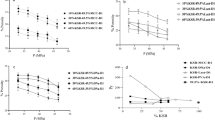Abstract
The dissolution behaviour of a direct compression compact prepared with sodium diclofenac and dibasic calcium phosphate (DCP) in different weight ratios with or without Biosoluble polymer® (acrylic-based resin) was investigated in distilled water and in a medium with changing pH. The results indicate that the amount of sodium diclofenac released from the compact was dependent on the amount of drug and DCP used in the compact, and was also controlled by the amount of Biosoluble polymer® added. A chemical reaction forming diclofenac acid might occur on the surface of the sodium diclofenac compact during exposure to the acidic medium, which was confirmed by diffuse-reflectance spectroscopy. The tablet with a 1∶2 weight ratio of sodium diclofenac to DCP exhibited a sustained-release behaviour, similar to commercial sustained-release products (Voltaren SR-100® and Grofenac Retard®), but a lower release rate was found as compared to the commercial products. The dissolution behaviour of the study tablet and the commercial products was found to be dependent on the dissolution medium and the rotating speeds. Glass beads were added to the dissolution assembly to simulate the influence of food, and the enhanced friction between tablet and glass beads might result in a higher dissolution rate of the tablet and the commercial products.
Similar content being viewed by others
References
Lapidus H, Lordi NG. Drug release from compressed hydrophilic matrices. J Pharm Sci 1968;57:1292–301.
Martinez-Pacheco R, Vila-Jato JL, Concheiro A, Souto C. Effect of compression force on biopharmaceutical characteristics of Eudragit RS-based cephalexin tablets. Int J Pharm 1988;47:37–42.
Shangraw RF, Wallace JW, Bowers FM. Morphology and functionality in tablet excipients for direct compression. Pharm Technol 1987;11:136–45.
Parrott EL. Comparative evaluation of a new direct compression excipient, Soludex 15. Drug Devel Ind Pharm 1989;15:561–83.
Lin SY, Kao YH. Effect of Eudragit resins and dibasic calcium phosphate on the compaction and dissolution behavior of directly compression controlled-release theophylline tablets. Drug Devel Ind Pharm 1990;16:855–74.
Lin SY, Hou SJ, Perng RI. Effect of direct compression or spray-dried encapsulation on the salbutamol release from hydrophilic matrix tablets. Chin Pharm J 1992;44:153–60.
Lin SY, Hou SJ. Preparation and evaluation of direct compressible controlled-release salbutamol tablets with Eudragit RLPM/RSPM and calcium phosphate. Acta Pharm lugo 1992;42:99–108.
Lin SY, Tau J, Wu WH, Perng R, Chang HN. Biopharmaceutic evaluation of controlled-release hydrophilic-matrix tablets containing encapsulated or unencapsulated salbutamol sulfate. Curr Ther Res 1992;52:486–92.
Lin SY, Lin TL. Different types of direct compressible excipients affecting the release behavior of theophylline controlled-release tablets containing Eudragit resins. Drug Dev Ind Pharm 1993;19:1613–21.
Lin SY. Effect of excipients on tablet properties and dissolution behavior of theophylline-tableted microcapsules under different compression forces. J Pharm Sci 1988;77:229–32.
Lin SY, Yang JC. Effect of ethylene-vinyl acetate as a coacervation-inducing agent on the production and release behavior of chlorpromazine hydrochloride microcapsules and tabletted microcapsules. J Contr Rel 1986;3:221–8.
Fassihi AR. Kinetics of drug release from solid matrices: Effect of compaction pressure. Int J Pharm 1987;37:119–25.
Rabasco AM, Holgado MA, Fernadez-Arevalo M, Gines JM. Inert matrix tablets as a controlled release dosage form for carteolol hydrochloride. Eur J Pharm Biopharm 1991;37:147–53.
Lin SY, Lin PC. Preparation and evaluation of sodium diclofenac controlled-release tablets (I): selection of different sources and types of directly-compressible excipients. Chin Pharm J 1994;46:53–62.
Wu WH, Chin TF, Lach JL. Interaction of isoniazid with magnesium oxide and lactose. J Pharm Sci 1970;59:1234–42.
Lin SY, Kao YH. Tablet formulation study of spray-dried sodium diclofenac enteric-coated microcapsules. Pharm Res 1991;8:919–24.
Shiromani PK, Bavitz JF. Studies on a dibasic calcium phosphate-mannitol matrix tablet formulation — a complementary combination. Drug Dev Ind Pharm 1988;14:1375–87.
Carstensen JT, Ertell C. Physical and chemical properties of calcium phosphates for solid state pharmaceutical formulations. Drug Dev Ind Pharm 1990;16:1121–33.
Garr JSM, Rubinstein MH. The effect of rate of force application on the properties of microcrystalline cellulose and dibasic calcium phosphate mixtures. Int J Pharm 1991;73: 75–80.
Sallmann AR. The history of diclofenac. Am J Med 1986;80Suppl 4B:29–33.
Solubility and distribution phenomena. In: Martin A, Swarbrick J, Cammarata A, editors. Physical pharmacy. 3rd ed. Philadelphia: Lea & Febiger, 1983:272–313.
Johnson JC, editor. Sustained release medications. New Jersey: Noyes Data Co., 1980:3–33.
Welling PG. Interactions affecting drug absorption. Clin Pharmacokinet 1984;9:404–34.
Hendles L, Weinberger M, Milavetz G, Hill M, Vaughan L. Food-induced dose dumping from a once-a-day theophylline product as a cause of theophylline toxicity. Chest 1985;87:758–65.
Author information
Authors and Affiliations
Rights and permissions
About this article
Cite this article
Lin, SY., Cheng, CL. & Lin, PC. Preparation and evaluation of sodium diclofenac controlled-release tablets. Pharm World Sci 17, 42–47 (1995). https://doi.org/10.1007/BF01875053
Accepted:
Issue Date:
DOI: https://doi.org/10.1007/BF01875053




